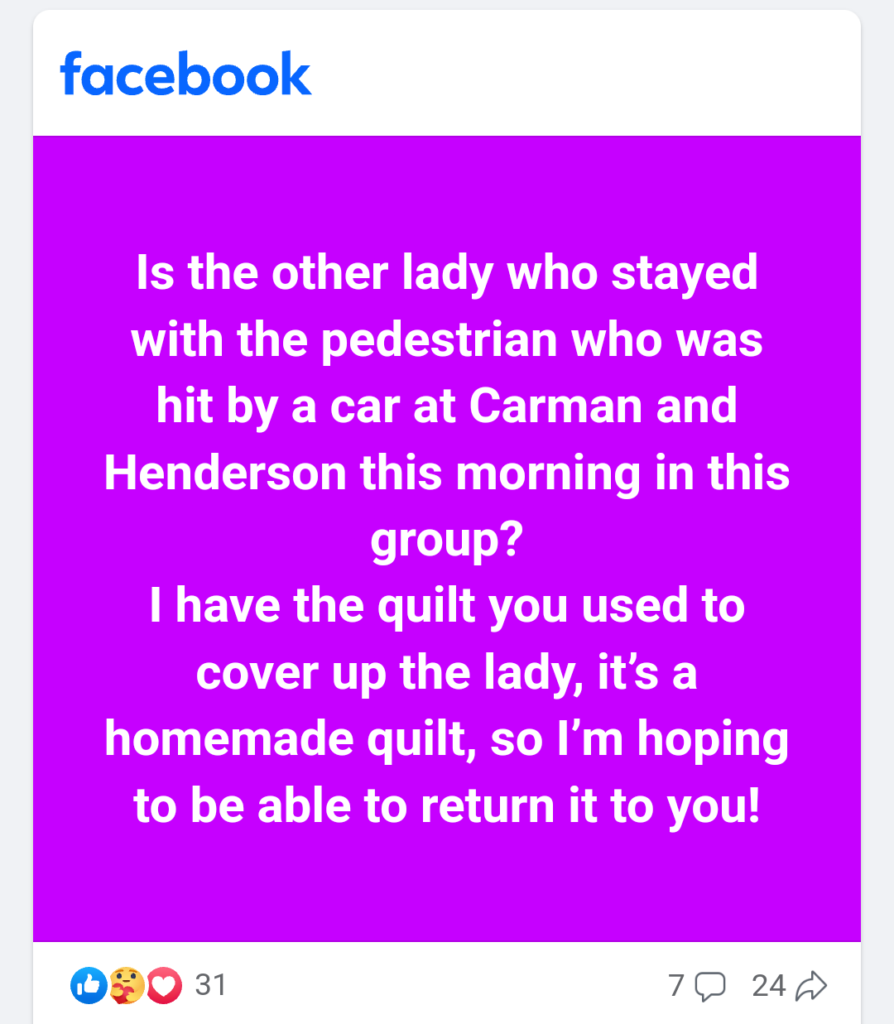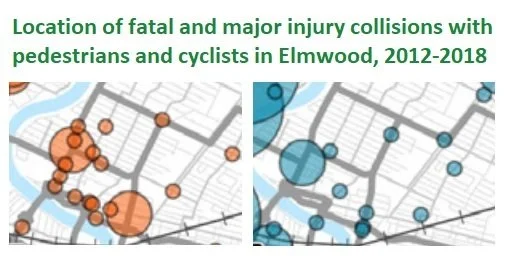My Neighborhood Is a Place
This article was originally published, in slightly different form, on Strong Towns member Michel Durand-Wood’s blog, Dear Winnipeg. It is shared here with permission. All images for this piece were provided by the author.
I don’t know who needs to read this, but my neighborhood is a place.
That may sound obvious on the face of it. After all, by the most basic definition of a place, as a particular point in space, isn’t everyone’s neighborhood a place?
A place to come home to. A place where your kids play. A place where you walk your dog. A place you receive guests in. A place you love and take care of. Your place.
And it is that. Until someone else acts like it isn’t.
You see, no one ever has a problem recognizing their own neighborhood as a place. But how you experience other people’s neighborhoods, and therefore whether you acknowledge and treat them as places, will largely depend on how you get around.
That’s because our own neighborhoods are the one place that we all spend time in outside of a vehicle. Sure, you may leave or arrive in a vehicle, but once you’re there, you experience your own neighborhood directly, without a buffer of two tons of steel, glass, and various plastics. Your sensory experience in your own neighborhood is unfiltered, at least some of the time: the result of a direct human-to-place interaction that’s impossible when separated from your surroundings by an artificial shell.
Jason Slaughter of YouTube’s Not Just Bikes had a great video a few months ago on the design of great urban places. While he mostly focuses on the layout and built form of buildings and public amenities that make up good places, near the end he remarks that when we design places with the movement of cars as a priority, we end up with places that don’t have any “sense of place.” And that’s true, especially for the places we design from scratch nowadays.
But what I found most interesting is that he notes that how he navigates when in North America is different than when he is at home in Amsterdam. When moving about his original hometown of London, Ontario, for example, his mental map is of major streets and cardinal directions. But when in Amsterdam, his trips are experienced as a series of unique places and landmarks.
Part of that is the physical design of those places, as the video points out. But part of it is as much the mode of transportation itself. As humans, our brains can only process so much visual information at one time. The faster we travel, the less we can see, as the “cone of vision” our brain can process gets smaller.
(Source: A Playful City, based on data from NACTO.)
Being in a fast-moving car literally erases the place you’re travelling through, leaving you to focus only on which road you’re on, and which direction you’re headed.
You’re no longer in a place. You’re on the way to a place.
That may be fine on a highway, but what happens when you’re traveling through a neighborhood, someone else’s place, at high speeds? How does it affect your opinion of that neighborhood? And how does it affect the people who live there, go to school there, or own a business there?
I know my neighborhood of Elmwood in Winnipeg, Manitoba, has a reputation for being somewhat rough, having long ago been given the derisive nickname of “Elm’hood” by outsiders. But in my nearly two decades of living here, I’ve found that reputation unjustified. Elmwood is a beautiful place with a rich history, filled with friendly, thoughtful, caring people working hard to improve the lives of everyone here.
But that perception gap is real. You even see it in the media. This article about a mother being “attacked while defending her daughter from a group of machete-wielding teenage boys” originally said it happened at her home in Elmwood, despite the address clearly being deep in the heart of East Kildonan. They corrected the headline and article text, but you’ll notice the URL still shows the original assumption that if something bad happened, it must have been in Elmwood.
Meanwhile, this good news story about a new business setting up shop on Henderson at Carmen Ave was originally misreported as East Kildonan. Again, the article was corrected, but the URL still betrays the fact that someone at the newspaper thought it was impossible for good news to come from Elmwood.
“This new location is in a revitalizing corner of the city, and I see only good things happening here.”
— Keith Clark, owner of NetPrintShip on his decision to open up shop in Elmwood
If you never get to experience my neighborhood up close and in person, you could be forgiven for having a skewed opinion of this place. But if it were only about mistaken perceptions, I wouldn’t be writing this.
Because traffic moving quickly through my neighborhood has much more dire consequences than whether we get credit for being awesome or not.
Last Thursday morning, a person walking in my neighborhood was going about her daily business when she was struck by a someone driving a car, at the corner of Henderson and Carmen Avenue.
I know that corner well because it’s only about a half block from my home, and I pass through there several times per week on my way to various activities and errands.
And every time I do, I feel the same thing: anxiety. Because this is a dangerous place. And somehow, the part of my brain that regulates my most primal self-preservation instincts knows it.
That feeling is never more heightened than on Saturday afternoons. That’s when I go through there on my way to the local curling club with my three kids to attend the youth curling program.
So while I was sad to learn of this crash, I wasn’t surprised.
And when I learned that she wasn’t crossing the six-lane nightmare that is Henderson, but that she was crossing Carmen Avenue, the residential side street, that didn’t surprise me either.
Because drivers turning off of Henderson onto Carmen Avenue aren’t looking for people on foot, they’re looking for a gap in three lanes of 60-kilometer-per-hour (37 mph) traffic. At those kinds of speeds, there’s no time to focus on what’s happening in the surrounding place.
That’s the impact of people driving through your neighborhood at high speeds.
And sure, sometimes you hear about it through some story on the news, like when this car flipped on its roof and slammed into a tree on Henderson near Carmen Avenue.
And sometimes, it shows up in some city report of fatal and major injuries:
(Adapted from Current State Report: Winnipeg Transportation Master Plan 2050. Orange: pedestrian collisions, blue: cyclist collisions.)
But most of the time, the only documented proof that anything happened at all is some random Facebook post of a neighbor looking to return a blanket.
This is our normal.
But it wasn’t always. And it doesn’t have to continue to be.
The people of Elmwood have been pushing to slow traffic through here for decades, not only to achieve the bare minimum of basic safety, but also for livability and enjoyability. This is our place and we want it to do well. And that’s hard to do with a high-speed thoroughfare bisecting your community.
But while most people wouldn’t find that to be an unreasonable ask for their own neighborhood, when it comes to Elmwood, we’ve still found the most vehement opposition to slowing traffic has come from people outside the neighborhood. Many of those driving through here do not think that they should slow down just because the people who live and work in a place want it.
Until the shoe is on the other foot.
When someone removed the barricades on the Raleigh Street walking-biking route at the northern edge of the city so cars could drive through, the uproar from the residents of North Kildonan was swift. The area’s councilor condemned the change, urging the province to replace the barricades as quickly as possible, even going as far as insisting that the neighboring municipality of East St. Paul provide written guarantees that its future development won’t be dense enough to greatly increase traffic through North Kildonan.
“This is a … residential neighborhood with residential streets… None of them were designed with the notion of becoming another Henderson Highway,” says an area resident in the news story.
That’s all well and good, but it would be important to remember that Henderson Highway wasn’t designed with the notion of becoming Henderson Highway, either. This was Kelvin Street, until people driving through here decided it wasn’t.
Imagine if we treated our homes the way we treat our neighborhoods.
When someone comes to visit, especially in winter, we have them take their boots off at the door before they walk into the living room. But let’s say they told you, “Actually, I’m a little hungry, so I’m really headed to the kitchen. I’ll take my boots off when I get there.”
Would you let them? Further, would you rearrange the living room furniture to make sure they have an unimpeded path? Would you remove the rug and the houseplants to create a clear zone? And when the living room became too noisy to bear from all the boot traffic, messy from the melted snow and mud, and dangerous from all the high-kicking boots, would you be surprised when no one really wants to hang out in the living room anymore? And would you accept it when your visitors told you that if you don’t like it, you should just move?
Or would you rather have visitors take their boots off at the door, politely say hello to your grandma who’s knitting in the living room, as they gingerly make their way to the kitchen for a refreshing taste of the future?
Having the city prioritize high-speed traffic through your neighborhood is like having people traipse through your living room with their boots on.
Transportation and land-use planning are two sides of the same coin. It takes more than well-placed buildings and public amenities to make a neighborhood into a livable place. Even if we get all the land use right, the choices we make with respect to transportation still have the potential to make or break a place.
Think about this the next time you’re going through someone else’s neighborhood. This is someone’s place. And you have the potential to help make it, or break it.
So, whether you’re coming here to visit or just passing through, on behalf of the people and businesses of Elmwood, I’d like to say: welcome to our place!
Just take your boots off at the door.
RELATED STORIES
#BlackFridayParking
Even during the busiest shopping season, we have too much parking. It's time to get rid of the regulations that make it so.









Michel Durand-Wood lives in the Winnipeg neighborhood of Elmwood with his wife and three children. He writes at DearWinnipeg.com, a really fun blog about infrastructure and municipal finance. He has no formal training or education in city planning, municipal finance, infrastructure maintenance, or anything else he talks about. He's just a guy, in love with a city, asking it to make better use of his tax dollars.